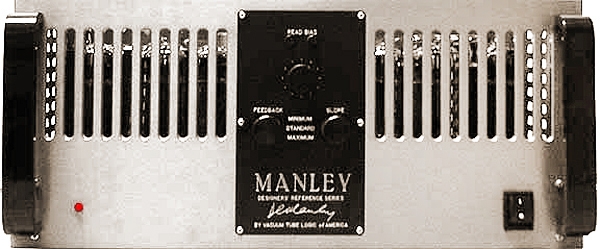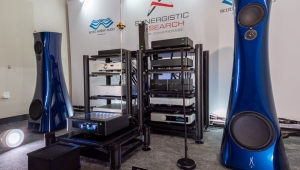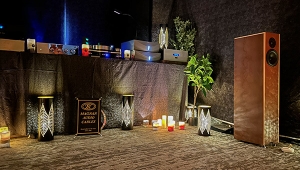| Columns Retired Columns & Blogs |
VTL/Manley Reference 350 power amplifier

Manley is not a new company; it's the last name of the president and chief designer of VTL, David Manley, whose Model 300 has been my reference standard power amp for the past two years. In fact, Manley is not even a new brand name; it's the name of VTL's "deluxe" line of electronics, built (ostensibly) to industrial standards of ruggedness and reliability.
Footnote 1: Output-transformerless operation has always looked like an attractive solution, but has always become hung up on the choice between using huge output-coupling capacitors, which roll-off low frequencies anyway, or direct-coupled outputs whose DC balance must at all times be extraordinarily accurate in order to avoid offsetting or burning-out the woofer voice-coil.
It's customary to think of "the tube sound" as being warm, rich, weak through the deep bass, fat through the midbass, forward through the midrange, bright through the middle highs, and soft at the extreme top, with superb rendition of depth and spaciousness. The "solid-state sound," by contrast, is generally thought to be cool, detailed, and pristine, with powerful deep bass, controlled midbass, rather reticent (laid-back) midrange and mid-highs, and a somewhat crisp high end, with variable (roulette-style) reproduction of depth and spatiality. Which "sound" is generally better is still argued by those who will acknowledge at all that amplifiers sound different, but the fact is that neither is intrinsically better. It's just that one "kind" of sound will better complement the sound of a particular loudspeaker (and preamp) than the other, so "the best" is pretty much a question of what's best in your system.
With the wrong speakers, that rich, musical, tubed amplifier will sound flabby and dull, or that tight, detailed, solid-state amplifier will sound thin and sizzly. This is simply an audio fact of life: Different loudspeakers "prefer" different kinds of amplifiers. But that has not deterred designers from trying, for the past 10 years or so, to make an amplifier which is all things to all systems—that is, to make their solid-state electronics sound more like tubes, or their tubed electronics sound more like solid-state. The goal has always been a device that combined the assets of each kind of amplifier with the fewest sonic liabilities of each. And while different reviewers will nominate different products as exemplifying this seeming ideal, perfection in amplifiers continues to elude us, because as long as loudspeakers differ as much as they do, no one amplifier "sound" can best serve them all. (Sorry, Bill J, but that's the way it is in the real world.) Even the most nearly perfect amplifier—the one that is neither forward nor laid-back, sparse nor bass-heavy, soft nor crisp—is ultimately at the mercy of its associated components. In many cases, a less perfect, more colored amplifier will deliver more musically natural sound than the "ideal" amplifier. This is why it is unwise to base a product purchase solely on a published review.
Because the laws of physics impose conflicting requirements on output transformers, tubed amplifiers have always suffered from edge-band deficiencies—poor LF coupling to the woofers, and HF rolloff and phase shift (footnote 1). Also contributing to the "tube sound" is the fact that tube circuits tend to be less linear than those using modern solid-state devices; they have higher distortion. This is what gives most tubed amps that rather forward quality which enhances "aliveness" and realism on some loudspeakers and becomes a steely edge ("glare") on others. What saves the tube from utter dissonance is the fact that its distortion content diminishes with the harmonic progression; that is, each harmonic in the series is substantially weaker than the one below it. While a tubed amplifier may measure a sleazy-looking 0.3% THD as compared with a solid-state amp's 0.03%, that tube distortion is likely to be mainly 2nd and 3rd harmonics. At the higher orders—the 4th, 5th, 6th, and so on, which tend to be the most aurally offensive—the tube may be down to 0.01% or less distortion, while the transistor is still pumping out 0.03% (footnote 2). (Note that I am not talking here about differing amounts of distortion of higher frequencies, but about differing amounts of energy at the higher harmonics of any given frequency.)
In solid-state design, the major areas of sonic improvement during the past 10 years have been due to refinements in the active devices themselves, which are subject to constant improvement as manufacturers try to make their products better than the competition's. Modern tube-electronics design is still married to an active-device technology that's more than 60 years old. Even the circuits in virtually all non-hybridized (tube-and-transistor) tubed amplifiers come right out of the 1953 edition of the Radiotron Designer's Handbook, a 1500-page tome that was for many years considered the electronics designer's bible. The most significant improvements in tube performance since '53 have resulted from better power-supply and output-transformer design, changes in design philosophy (favoring lower distortion over higher gain-per-stage), and the use of vastly better resistors and capacitors than were available 40 years ago, when nobody even suspected that "passive" components could affect the sound.
At 80 lbs, the Manley 350 weighs 5 lbs more than the VTL 300, but is actually easier to move around because it has decent handles on the front. The 300 had no handles, although everyone uses the metal straps at the top for that purpose. David M. insists vehemently that they are not there for that purpose, but are merely to afford a modicum of protection for the otherwise-naked tubes. Indeed, if you lift by the middles of the straps, they will bend upward out of shape. But they won't if you grab them near opposite ends. They are still not comfortable to the hand, though. And there is really nothing else to grab hold of.
The 350's construction is generally impressive. The front panel is ¼" aluminum and the chassis is heavy-gauge steel, but the top cover is a relatively flimsy perforated metal sheet that rings like a bell when you tap it. In theory, this ringing could be set off by in-room musical tones of the same frequency (around 190Hz), and in fact, when I had the amplifiers near the speakers, and shut off a 190Hz sinewave, I could hear (from the listening seat) the top-panel ringing fading out afterwards, but it was never audible when reproducing music. If you think you can hear it, there's nothing that says you can't use the amps without their covers. Just remember that the tubes run hot enough that you can get a painful although non-threatening burn by touching one, and that the uncovered amps must not under any circumstances be lifted off the floor using their handles. The cover has a supporting as well as protective role, and without it, the chassis could become bent out of shape if forced to support all that weight by itself.
l couldn't tell much about the 350's internal construction, because most of the parts are sandwiched between the top of the printed circuit board and a protective metal shelf. I could see, however, that all groups of visible wires inside the chassis are neatly harnessed together in military style.
While many other tubed amplifiers have become increasingly complex through the years, mainly through the addition of solid-state parameter-regulating circuitry, the Manley 350s are quite straightforward in design. The first voltage-amplifier stage is unusual only in that it uses both halves of a dual triode in parallel, to give higher gain (footnote 3) and lower noise. The second dual-triode tube comprises a floating long-tailed phase inverter, which has the advantages of being self-balancing (for more effective cancellation of even-order harmonics) and of having gain, which latter allows it to serve as the voltage driver for the four output tubes per push-pull side. (A conventional split-load phase inverter has less than unity gain.) All stages are capacitor-coupled, using Manley-spec custom-made capacitors, which are (according to Manley) unusual in that they consist of polypropylene-film dielectrics interleaved and rolled with metal-foil plates. Manley claims foil is superior to the usual deposited metal plates because it has more uniform thickness. I can't see what difference that would make, but what the hell...
The circuitry I've just described is also that of the VTL 300. So what's different about the 350 except for the extra 50W of power, which translates into a piddling 0.7dB of output? For one thing, the 350 has separate power supplies for the output-tube plates, the driver stage, and the input stage. And I do mean "separate." Each has its own dedicated power transformer and filter-and-storage caps; the only thing they share is the AC cord! This ensures that the voltage amplifier and phase inverter/driver plates see a constant supply voltage regardless of how much current the output stages are passing, thus preventing the output signal from amplitude-modulating the signal passing through the earlier stages. But does this power-source apartheid really have any significant effect on the sound? Read on.
All connections are at the rear of the chassis, and are gold-plated. The speaker terminals are five-way binding posts on standard ¾" centers, to accept dual banana plugs. On the front panel there are three rotary switches and two "pin-jack" receptacles, for a voltage/current meter. The associated switch connects the meter to each of the eight output tubes, and internal pots are provided for adjusting the bias to each tube. I would like to assume that the amplifiers are normally delivered with paperwork that mentions what the bias settings should be, though mine came with no paperwork at all. It strikes me, though, that it's pretty silly to make the bias settings so easy to check, and then put the adjustments themselves inside the amplifier, where you have to remove the top metal cage in order to get at them.
The other two front-panel switches are feedback adjustments, which allow you to select 20, 17, or 14dB of feedback, and to vary the amount of feedback stabilization. Few tubeophiles realize that there is more to feedback than a resistor and a path back to the first stage. All loop feedback circuits also include some kind of stabilizing network, usually consisting of a smallish-value capacitor across the feedback resistor. This increases the amount of feedback with increasing frequency, which serves to limit HF extension above the point where HF phase shift between the amplifier input and output might cause instability with certain "difficult" loads. Although the stabilization rolloff occurs well above the audible range, the phase lag that it causes can extend into the audio spectrum, and the resulting softness is one of the things that causes the vaunted "sweetness" of tubed amplifiers. Moving the rolloff to a higher frequency will open up the high end to some degree, but may also cause HF instability with certain loudspeakers, which causes an increasing tizziness at the extreme top.
Footnote 1: Output-transformerless operation has always looked like an attractive solution, but has always become hung up on the choice between using huge output-coupling capacitors, which roll-off low frequencies anyway, or direct-coupled outputs whose DC balance must at all times be extraordinarily accurate in order to avoid offsetting or burning-out the woofer voice-coil.
Footnote 2: I believe it was David Hafler who first proposed that it was the relative strengths of the upper harmonics that accounted for much of the HF difference between tubes and transistors—about 15 years ago. Since his observation was somehow deemed unfashionable, no one paid any attention. Today, harmonic distortion specs are still simply total-distortion figures, with no effort made to distinguish between the 2nd and the 8th harmonics. Oh well...
Footnote 3: I'm sorry, but it's sometimes impossible to avoid poor taste in these pages.
- Log in or register to post comments


































